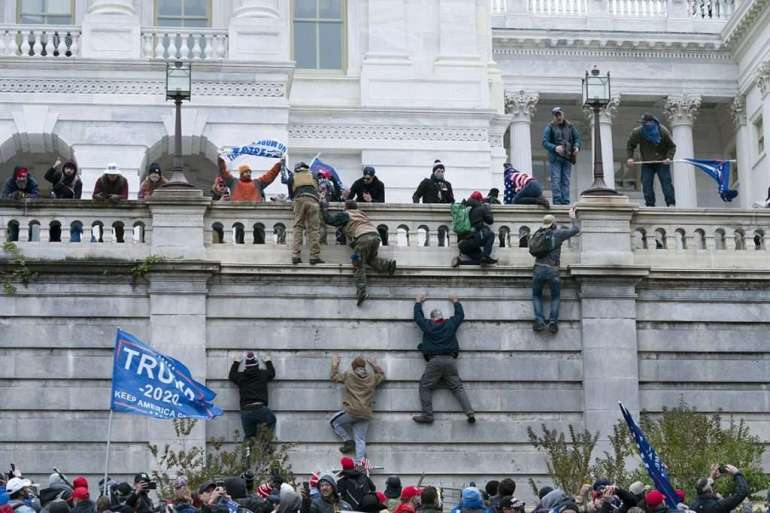Hundreds of law enforcement officials were prepped early for potential Jan. 6 violence

“Reporting indicates a significant number of individual [sic] plan to or are advocating for others to travel to Washington, DC to engage in civil unrest and violence,” reads the summary of the call, which included officials from so-called fusion centers — regional intelligence hubs set up after 9/11 to track major domestic threats.
The extent of the FBI’s awareness that the rally by Trump backers could turn violent raises fresh questions about why national security and law enforcement officials didn’t do more to protect the Capitol on that volatile day.
A few days after the riot, a top FBI official told reporters that the Bureau “did not have intelligence suggesting the pro-Trump rally would be anything more than a lawful demonstration,” according to The Washington Post. But the call summary shows that hundreds of officials at fusion centers around the country in fact saw the threat coming, and that they prepared for damaging unrest days before the first rioters broke into the Capitol.
A participant on the call said that the D.C fusion center, whose concerns prompted the telephone discussion, had shared information with U.S. Capitol Police about the threat — particularly notable given that the department’s since-resigned chief, Steven Sund, blamed federal intelligence agencies for the chaos during his testimony before Congress earlier this year.
Mike Sena, president of the National Association of Fusion Centers, sent the Jan. 4 email to undisclosed recipients. In it, he recapped the preparation call that took place that day.
“As Washington DC prepares for the Electoral Vote in Congress on January 6, and the inauguration of the President on January 20,” Sena’s email began, D.C.’s fusion center — known as the National Capital Region Threat Intelligence Consortium (NTIC) — “is working diligently to protect public safety, as well as privacy, civil rights and civil liberties.”
Sena’s group hosted the call that day with representatives from the country’s 80 fusion centers because officials at NTIC were growing alarmed about information indicating Trump supporters could engage in violence on Jan. 6. On the call, they alerted officials around the country to the threats they feared would materialize on the day of the Electoral College certification. People from all over the U.S. were threatening to come to D.C. and engage in violence, they warned — including some who planned to bring guns and who indicated they were in militia groups.
NTIC “has a collection requirement for individuals stating their intent to violate DC weapons laws and/or commit acts of violence at the upcoming major events in DC,” Sena wrote in his email, indicating that officials there had formally decided they needed specific intelligence on people making such threats ahead of the Jan. 6 events.
Those who dialed in also discussed the possibility that the Jan. 6 protests could turn into a mass-casualty event, the call participant said. And they specifically talked about threats to the U.S. Capitol building, as well as to other state capitals.
Sena and an FBI spokesperson declined to comment. A spokesperson for the NTIC did not respond to a request for comment.
In response to a request for comment, a Capitol Police spokesperson flagged a previously released statement: “Based on all the intelligence the USCP received before January 6, we were aware of the potential for violence from some demonstrators. Based on the intelligence, the Department enhanced its security posture. However, no one’s intelligence revealed the large-scale demonstration would become a large-scale attack.”
Sena’s email also described the FBI’s plans to use its eGuardian platform — which connects different law enforcement agencies — in the event of violence during the Jan. 6 vote to certify Trump’s loss to President Joe Biden.
“FBI eGuardian will be using the tag #CERTUNREST2021 to track, organize and coordinate incoming threats related to the upcoming January 6th, 2021 meeting by Congress to certify the results of the 2020 Presidential Election,” Sena’s email said.
The email then included notes from the call about Jan. 6, showing that call participants talked about specific groups that planned to descend on Washington. Names of those groups would be shared in an internal FBI database, Sena wrote, and the Department of Homeland Security would create a specific online hub “for the January 6 event.”
His email also confirmed that fusion centers around the country were paying attention to Trump supporters’ activity in the lead-up to the Electoral College certification: “A number of fusion centers also reported planned car caravans this week and MAGA Drag the Interstate rallies that are reported in conjunction with ‘Occupy the Capital’.”
Ryan Shapiro, executive director of the transparency watchdog group Property of the People, which obtained the email through an open records request, said it raises more questions about why the U.S. Capitol Police weren’t ready for chaos on Jan. 6.
“The intelligence was there in blinking neon lights, yet Capitol Police leadership went willfully blind,” Shapiro said in a statement. “The question is why. Why did Capitol Police leadership ignore the clear threat of the coming coup?”
Carrie Bachner, a former senior official in the Department of Homeland Security, said the call highlights the role fusion centers can play in preventing terrorism.
“If they’re run well and coordinated well, fusion centers are the holy grail for mitigating threats,” she said. “This call shows the fusion centers were coordinating, and it’s unfortunate that the U.S. Capitol Police were not prepared properly from a resources perspective on that day.”